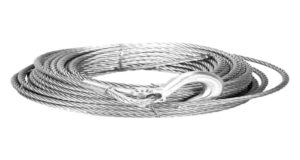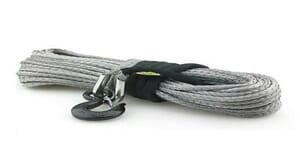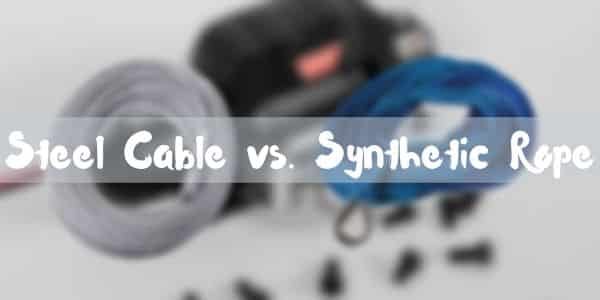Last Updated on September 20, 2021
Maybe you’re looking for a winch but can’t decide between steel cable and synthetic rope. You’ve spent countless hours researching and asked all your offroader buddies but still confused which will best suit your needs.
We understand that it’s not easy to decide. Both winch cable/rope have their pros and cons and you have to understand them clearly before making a choice.
After a deep research, we’ve put together a list of things to consider including the pros and cons of both types to help you make the right choice.
Before we dive deeper, let’s check our recommended rope/cable options first.
- WARN 61950 7/16″ – 90 ft Length & 16,500 Lbs (Best option for Jeep & Truck)
- Tie Down 59390 3/16″ – 50 ft Length & 4200 Lbs (Best option for ATV, UTV, Motorcycle)
- WARN 60076 3/16″ – 50 ft Length & 2500 Lbs (Premium option for ATV, UTV, Motorcycle)
Recommended Synthetic Rope:
- X-BULL SK75 3/8″ – 100 ft Length & 23,809 Lbs (Best option for Jeep & Truck)
- WARN 87915 3/8″ – 100 ft Length & 10,000 Lbs (Premium option for Jeep & Truck)
- FieryRed 3/16″ – 50 ft Length & 8200 Lbs (Best option for ATV, UTV, Motorcycle)
- WARN 72128 3/16″ – 50 ft Length & 4200 Lbs (Premium option for ATV, UTV, Motorcycle)
- Ucreative 1/4″ – 50 ft Length & 7700 Lbs (Cheaper option for ATV, UTV, Motorcycle)
Quick Navigation
Steel Cable VS. Synthetic Rope for Winch
There is a big divide between offroad enthusiast when it comes to choosing between steel cable and synthetic rope.
Inherent safety is probably the major difference between a synthetic rope and steel cable. When steel cable breaks, it creates a really dangerous situation.
But it is clear that the popularity of synthetic rope has highly increased in the last two decades.
Steel Cable: The Industry Standard

Steel winch cable has been the industry standard for many decades. It is the perfect line to use on mud, rocky, or sandy terrain as it is less prone to fraying and abrading under these highly abrasive conditions.
There are also some more advantages of using steel cables. It requires less maintenance compared to synthetic types. Plus, they’re highly durable, don’t fray easily and good for use in both utility and recovery work.
Moreover, this cable is great for winching in tight places where friction can cause a problem. Also, it is less expensive than synthetic rope.
When using steel cable, follow these tips:
- A lot of energy released when a break happens. You have to fold a blanket over the cable center to absorb the energy.
- Keep the area clear. No one should be standing near the winching area.
- Maintain your cable properly.
One biggest negative point of steel winch line is the wear and tear it can create on your winch; if the line become burred frayed or rust while winching.
Steel winch cable also tends to develop sharp burrs, so hand gloves are required while handling the rope. This cable also develops kinks which makes it difficult to spool up on the drum rightly and decreasing strength.
Many wheelers keep their steel winch line coated with WD-40 or chain oil. This protects the steel by preventing rust.
Using a damaged steel winch line can cause a serious accident. It can break during use, cause serious damage to your vehicle or severe injury to you. So, you should check the steel cable for damage periodically to ensure safety.
Pros and Cons Of Steel Cable
Pros
- Strong, affordable and UV stable.
- Perfect for using on highly abrasive terrains.
- Requires less maintenance.
- Less expensive than synthetic types.
Cons
- Prone to kinks.
- Can create a spot on your winch.
- Difficult to handle and requires gloves.
- It’s difficult to fix the cable, it breaks in the field.
- Can be louder, depending on your winch.
Synthetic Rope: New and Innovative

The synthetic winch rope was first introduced in the mid-’90s as a safer alternative to the steel cable. It is made of hi-tech polyethylene and proven 15 times stronger than the steel cable.
It is much safer than the steel cable. If it breaks, it is much less likely to create injury than steel line. Moreover, you can re-braid the broken rope in the field by using some technique.
The synthetic line is significantly lighter than steel cable. It weighs only 1/7 of what seel cable. Also, it is flexible, easy to handle and floats in water which makes it great for use in water or mud.
Note: It doesn’t matter how lightweight the rope is, using proper gloves is highly recommended while handling either cable or steel.
You’ll also find roller fairlead and aluminum options for synthetic rope. This ensures that the heat produced from winch won’t damage the winch line. Synthetic rope can be quieter on your winch too, which may be important for your use.
This rope comes with a lot of helpful features, then why would you go for steel rope? Well, it has some cons too.
The biggest weakness of synthetic cable is its ability to hold water. This will make the winch difficult to use and add extra weight. While offroading in freezing temperatures, you should try to keep the winch line dry.
Synthetic rope requires high maintenance than the steel cable. Frequent use in mud and sand can harm the rope. So, special care must be taken after using in sand or muddy conditions. For proper care and maintenance, follow these tips:
- Frequently wash with soapy water.
- Invest in an anti-abrasion sleeve for protection.
- Use removable winch cover to keep debris out of the winch and protect from UV damage.
One bonus thing is that it is available in all sorts of dazzling colors that aren’t present in the steel cable.
Pros and Cons of Synthetic Winch Rope
Pros
- Flexible, Lightweight, Stronger
- Easier to handle.
- Floats in water/mud.
- It can be repaired in the field if breaks.
- Doesn’t store energy.
- Can be quieter, depending on your winch.
Cons
- Needs special care & Maintenance.
- Requires extra UV protection.
- Pretty expensive.
- Can hold water and freeze.
Video: Synthetic Winch Rope vs Steel Cable & Other Tow Ropes
Which One Should You Choose?
Now you’ve got enough knowledge about steel cable and synthetic rope. But which winch rope will be best for your needs?
The major plus point of the synthetic rope is that they weigh less and easier to handle. That’s why their popularity is growing day by day.
But when it comes to failure rate, some experts stated that the failure rate is higher in synthetic rope than the steel cable. But it doesn’t mean that one is better than others.
As James Slomka said in the comment section, “Synthetic rope develops small tears that at times you don’t notice and they don’t give you a warning at failure. Steel cables start spinning when overloaded giving you warning, chains just split with no warning.”
If you decide on Synthetic rope, then make sure to be extra careful checking the rope from time to time. As they don’t give an obvious warning like steel cable.
We give priority to steel cable for their strength and simplicity. But if you’re looking for new and innovative, we say the synthetic rope is the way to go.
If you’ve looked at new models of winches recently, you may have found that synthetic rope winches are a bit more expensive than the steel cable winch. If money is a matter for you, then still cable can be a decent choice for you.
Remember that, synthetic rope has to be replaced every few years depending on sun exposure and use.
- WARN 61950 7/16″ – 90 ft Length & 16,500 Lbs (Best option for Jeep & Truck)
- Tie Down 59390 3/16″ – 50 ft Length & 4200 Lbs (Best option for ATV, UTV, Motorcycle)
- WARN 60076 3/16″ – 50 ft Length & 2500 Lbs (Premium option for ATV, UTV, Motorcycle)
Recommended Synthetic Rope:
- X-BULL SK75 3/8″ – 100 ft Length & 23,809 Lbs (Best option for Jeep & Truck)
- WARN 87915 3/8″ – 100 ft Length & 10,000 Lbs (Premium option for Jeep & Truck)
- FieryRed 3/16″ – 50 ft Length & 8200 Lbs (Best option for ATV, UTV, Motorcycle)
- WARN 72128 3/16″ – 50 ft Length & 4200 Lbs (Premium option for ATV, UTV, Motorcycle)
- Ucreative 1/4″ – 50 ft Length & 7700 Lbs (Cheaper option for ATV, UTV, Motorcycle)
Let’s enjoy the coming days and stay safe while winching! And please share this article if you’ve liked it.

More Winch Guides:
- Best 8000lb Truck Winch
- Best Battery For Winch – Detailed Review
- How To Choose The Best Battery For Off Road
- Car Hauler Winch Buying Guide
- Hitch Mounted Winch Buying Guide
- X bull Winch Review
- Smittybilt XRC Winches
- Superwinch Tiger Shark

I’m Daniel Galbreath, founder of OffRoadersWorld.
I spend my spare time writing on this website, OffRoaders World. I share my thoughts and reviews on different types of gears, share tips sometimes. This website is specially created and regularly updated basically to help other folks like me when I started to solve the various problems they face, specially when they go off-roading.

Thanks so much for your detailed input. I chose steel cable, the reason being I have work in a steel mill for 32 years . I am used to working with different slings, chains and numerous lifting devices over 50 tons. I know that there are many slings made out of nylon material in today’s industry. I have used them moving heavy equipment. They develop small tears that at times you don’t notice and they don’t give you a warning at failure. Steel cables start spinning over loaded, chains just split with no warning. Just my input to alarm anything underload can give out without warning. I just feel more comfortable with steel cable, less maintenance and old school.
That’s a really good point. I will mention this in the article crediting you. Really appreciate your input.